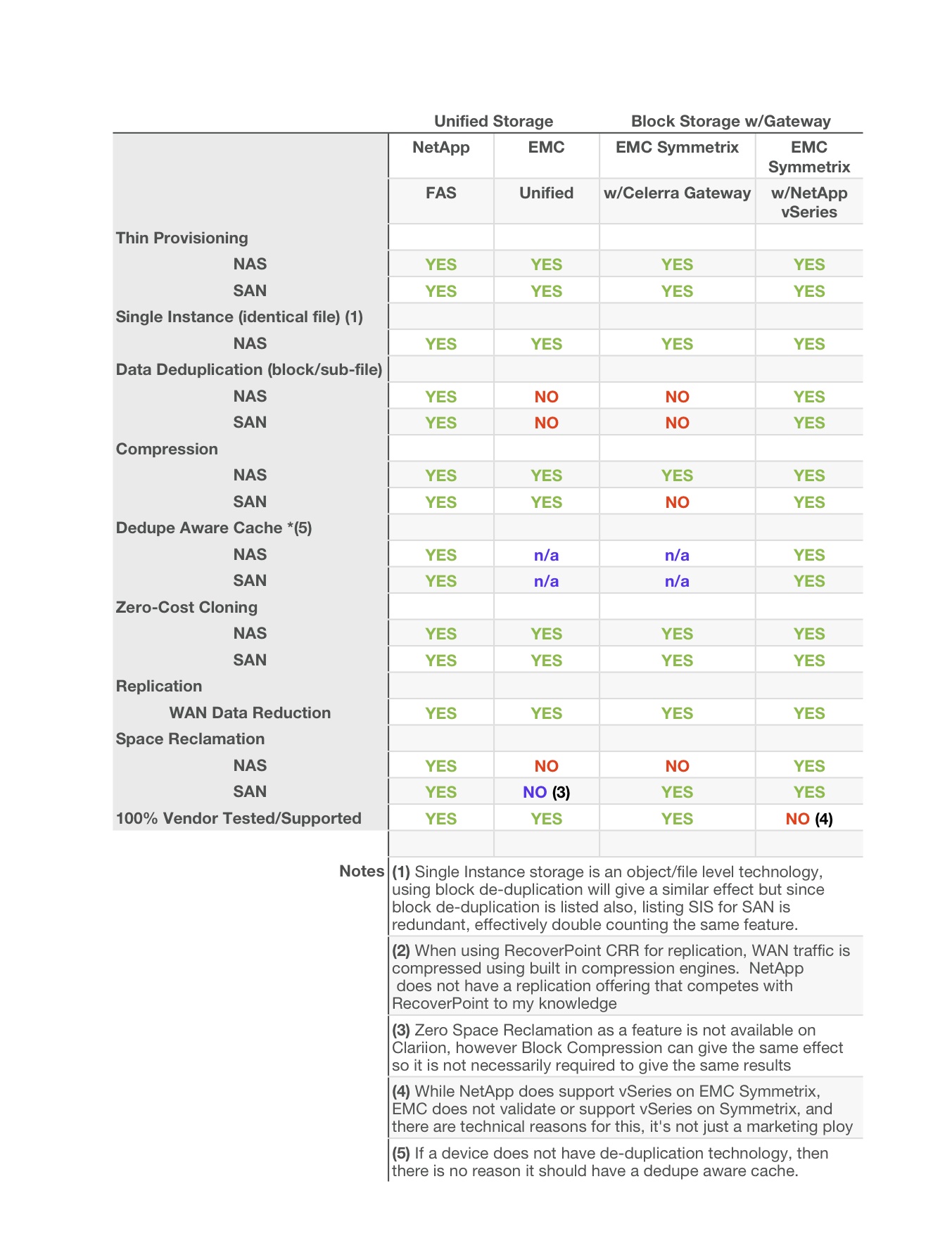Yesterday, In his blog posted entitled “Myth Busting: Storage Guarantees“, Vaughn Stewart from NetApp blogged about the EMC 20% Guarantee and posted a chart of storage efficiency features from EMC and NetApp platforms to illustrate his point. Chuck Hollis from EMC called it “chartsmithing” in comment but didn’t elaborate specifically on the charts deficiencies. Well allow me to take that ball…
As presented, Vaughn’s chart (below) is technically factual (with one exception which I’ll note), but it plays on the human emotion of Good vs Bad (Green vs Red) by attempting to show more Red on EMC products than there should be.
The first and biggest problem is the chart compares EMC Symmetrix and EMC Clariion dedicated-block storage arrays with NetApp FAS, EMC Celerra, and NetApp vSeries which are all Unified storage systems or gateways. Rather than put n/a or leave the field blank for NAS features on the block-only arrays, the chart shows a resounding and red NO, leading the reader to assume that the feature should be there but somehow EMC left it out.
As far as keeping things factual, some of the EMC and NetApp features in this chart are not necessarily shipping today (very soon though, and since it affects both vendors I’ll allow it here). And I must make a correction with respect to EMC Symmetrix and Space Reclamation, which IS available on Symm today.
I’ve taken the liberty of massaging Vaughn’s chart to provide a more balanced view of the feature comparison. I’ve also added EMC Celerra gateway on Symmetrix to the comparison as well as an additional data point which I felt was important to include.
 I’ve included some footnotes in the chart to explain some of the results but I’ll explain a little here as well.
I’ve included some footnotes in the chart to explain some of the results but I’ll explain a little here as well.
1.) I removed the block only EMC configuration devices because the NetApp devices in the comparison are Unified systems.
2.) I removed the SAN data row for Single Instance storage because Single Instance (identical file) data reduction technology is inherently NAS related.
3.) Zero Space Reclamation is a feature available in Symmetrix storage. In Clariion, the Compression feature can provide a similar result since zero pages are compressible.
I left the 3 different data reduction techniques as individually listed even though the goal of all of them is to save disk space. Depending on the data types, each method has strengths and weaknesses.
One question, if a bug in OnTap causes a vSeries to lose access to the disk on a Symmetrix during an online Enginuity upgrade, who do you call? How would you know ahead of time if EMC hasn’t validated vSeries on Symmetrix like EMC does with many other operating systems/hosts/applications in eLab?
The goal if my post here really is to show how the same data can be presented in different ways to give readers a different impression. I won’t get into too much as far as technical differences between the products, like how comparing FAS to Symmetrix is like comparing a box truck to a freight train, or how fronting an N+1 loosely coupled clustered, global cached, high-end storage array with a midrange dual-controller gateway for block data might not be in a customer’s best interest.
What do you think?

